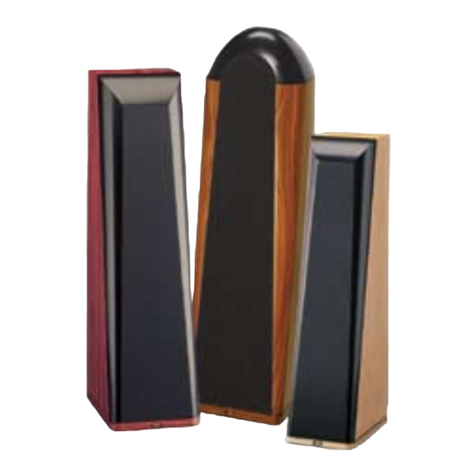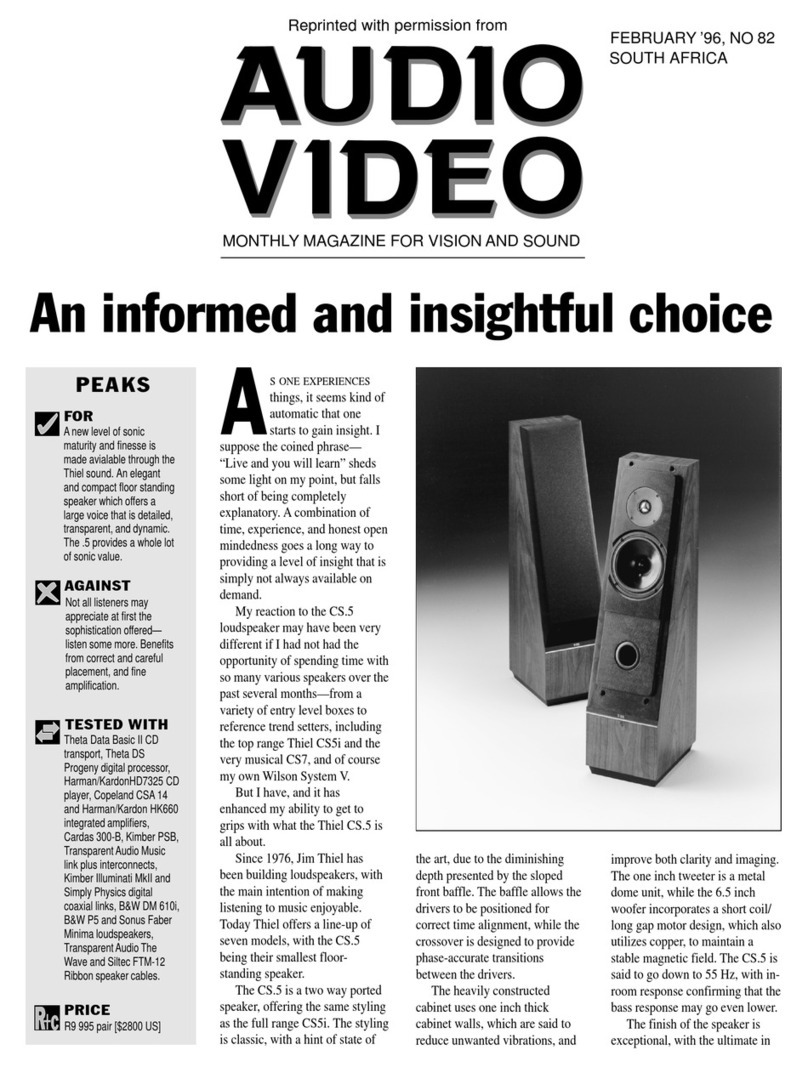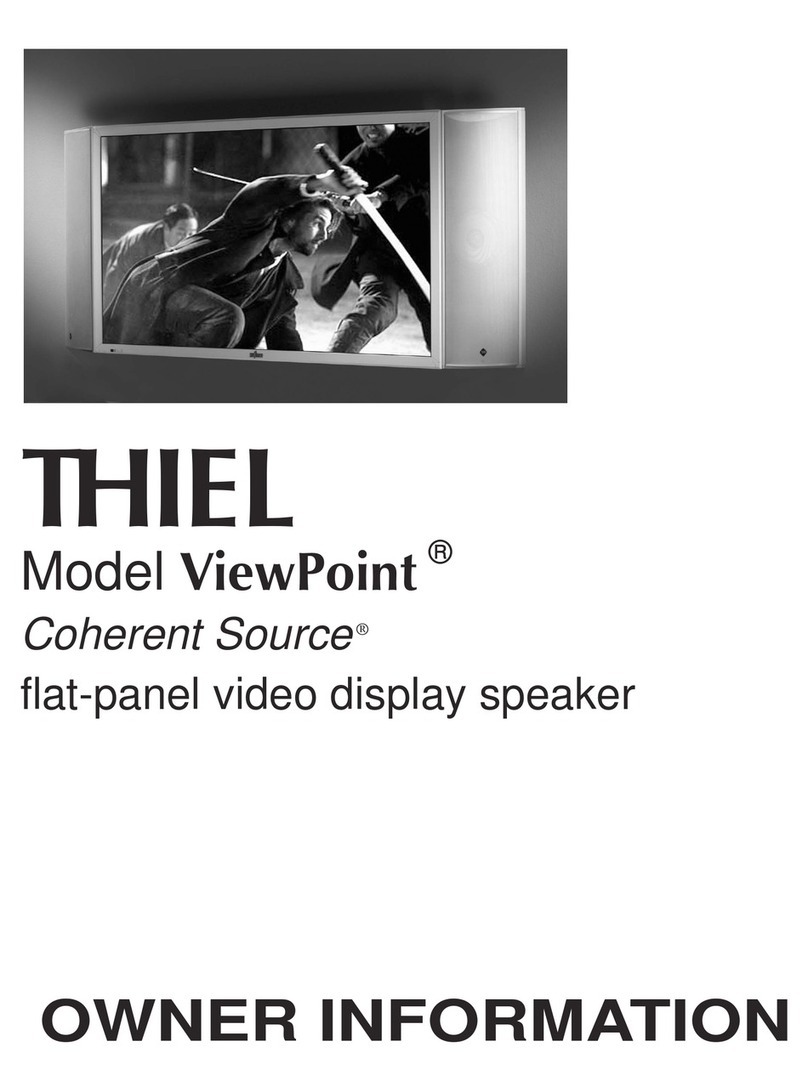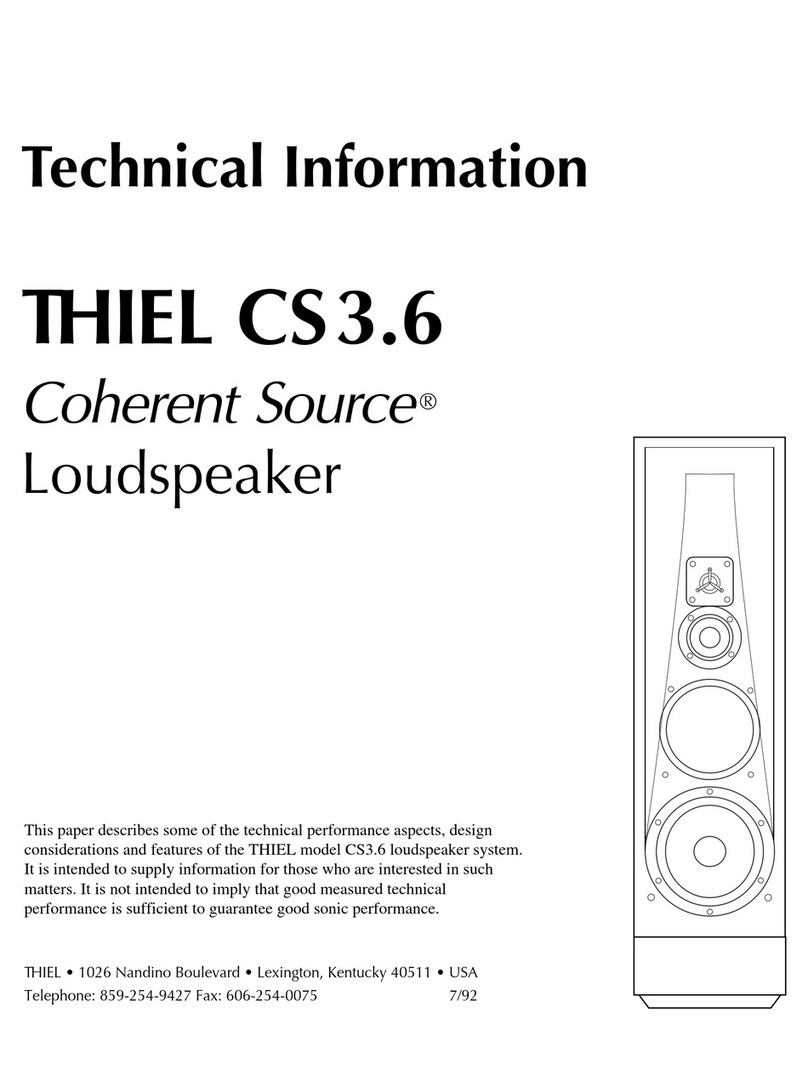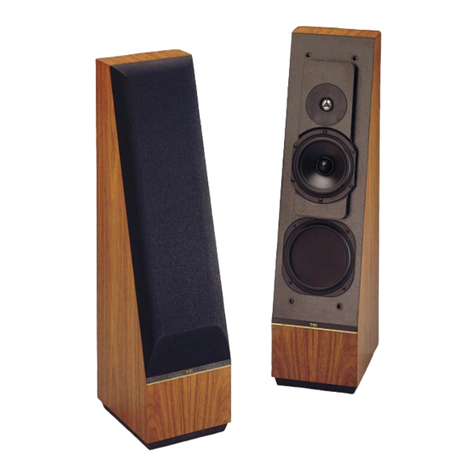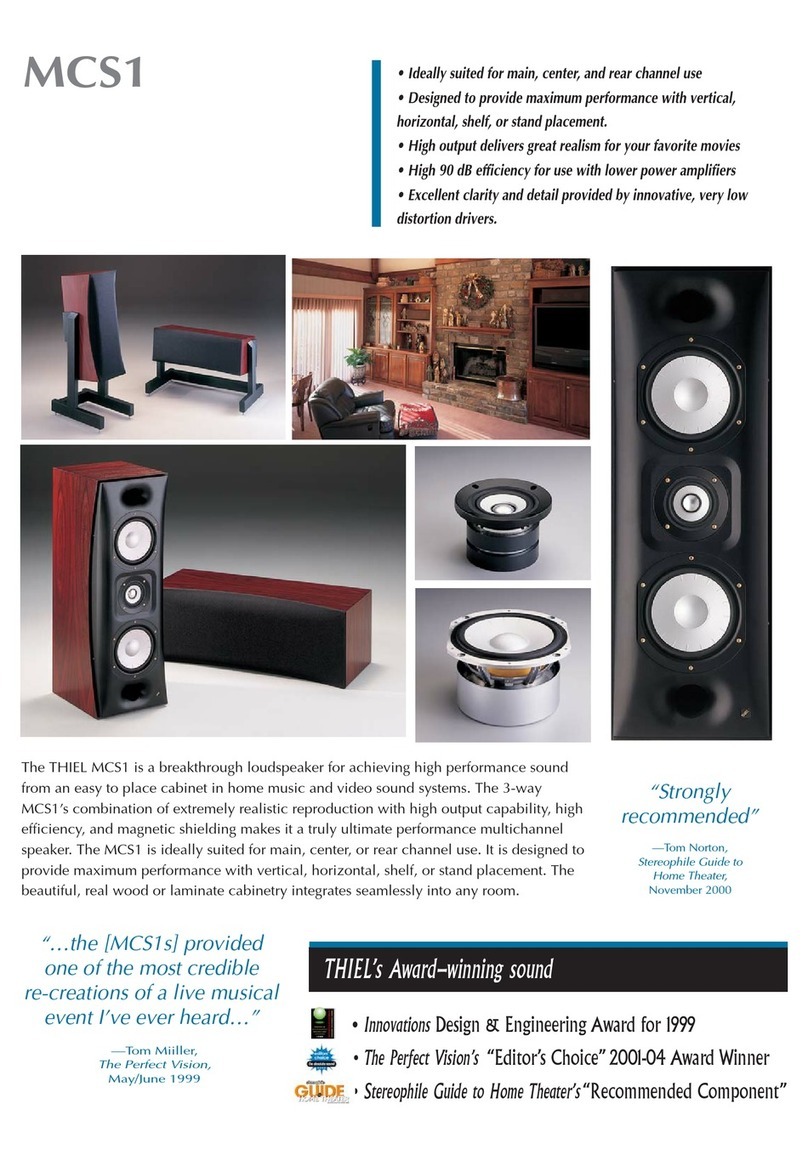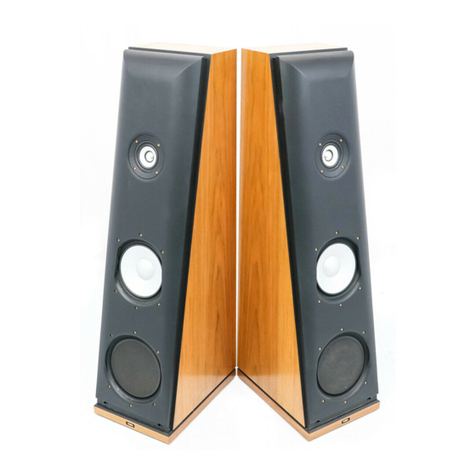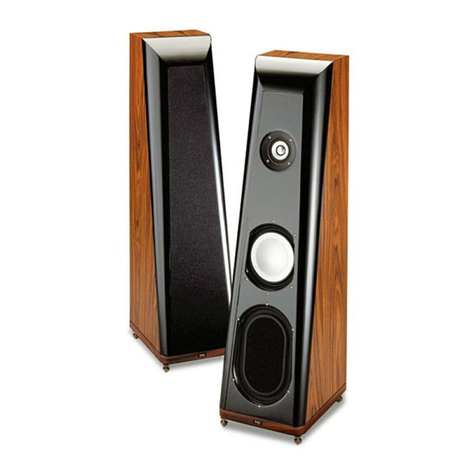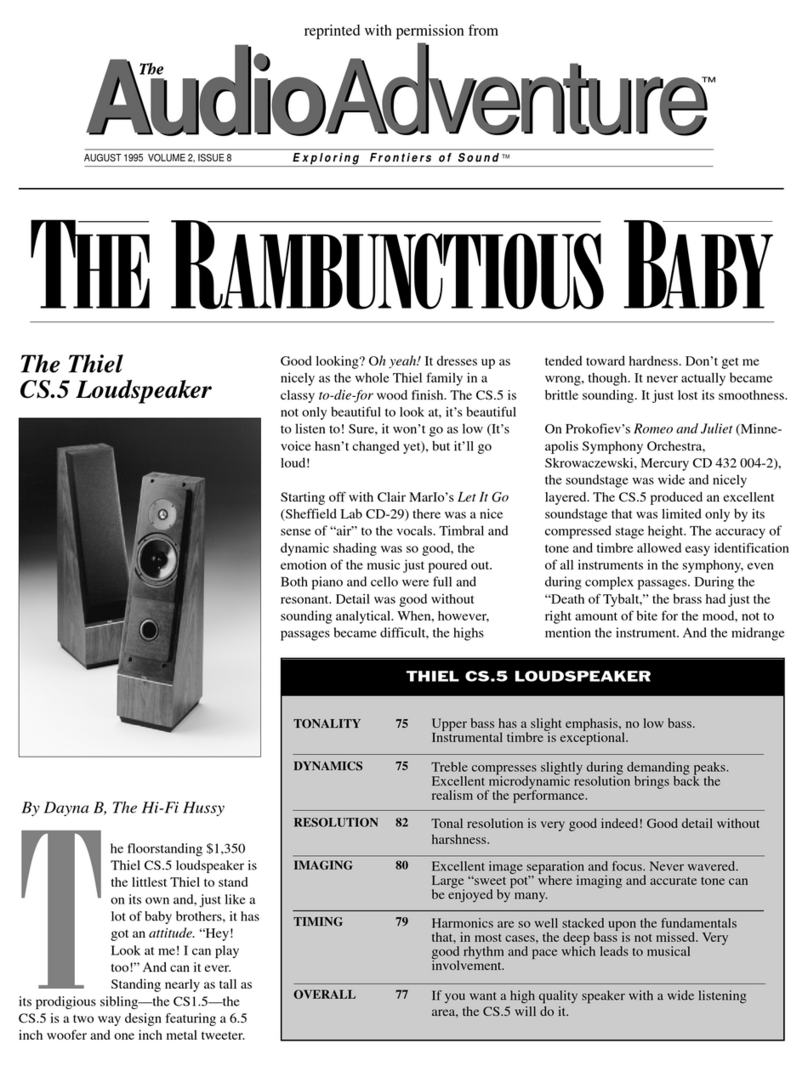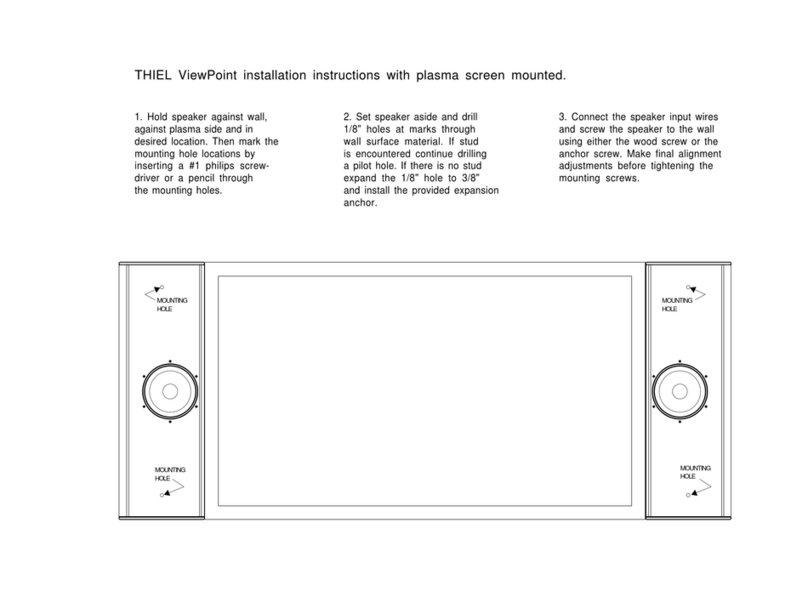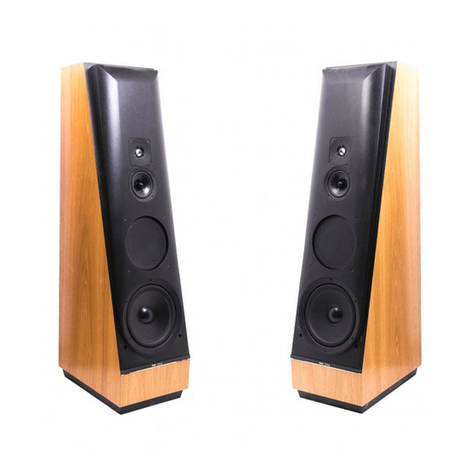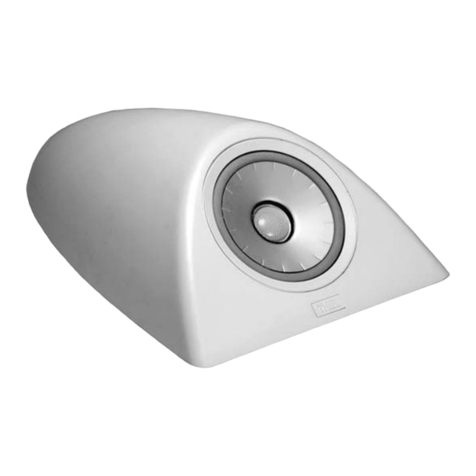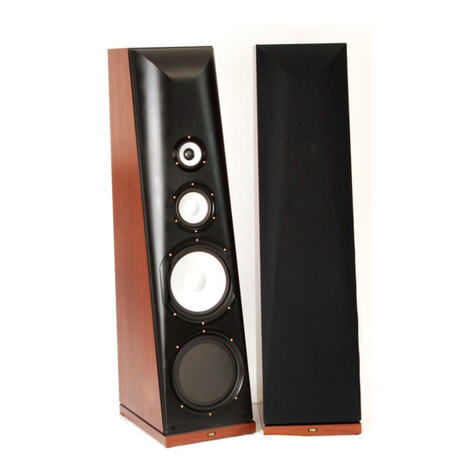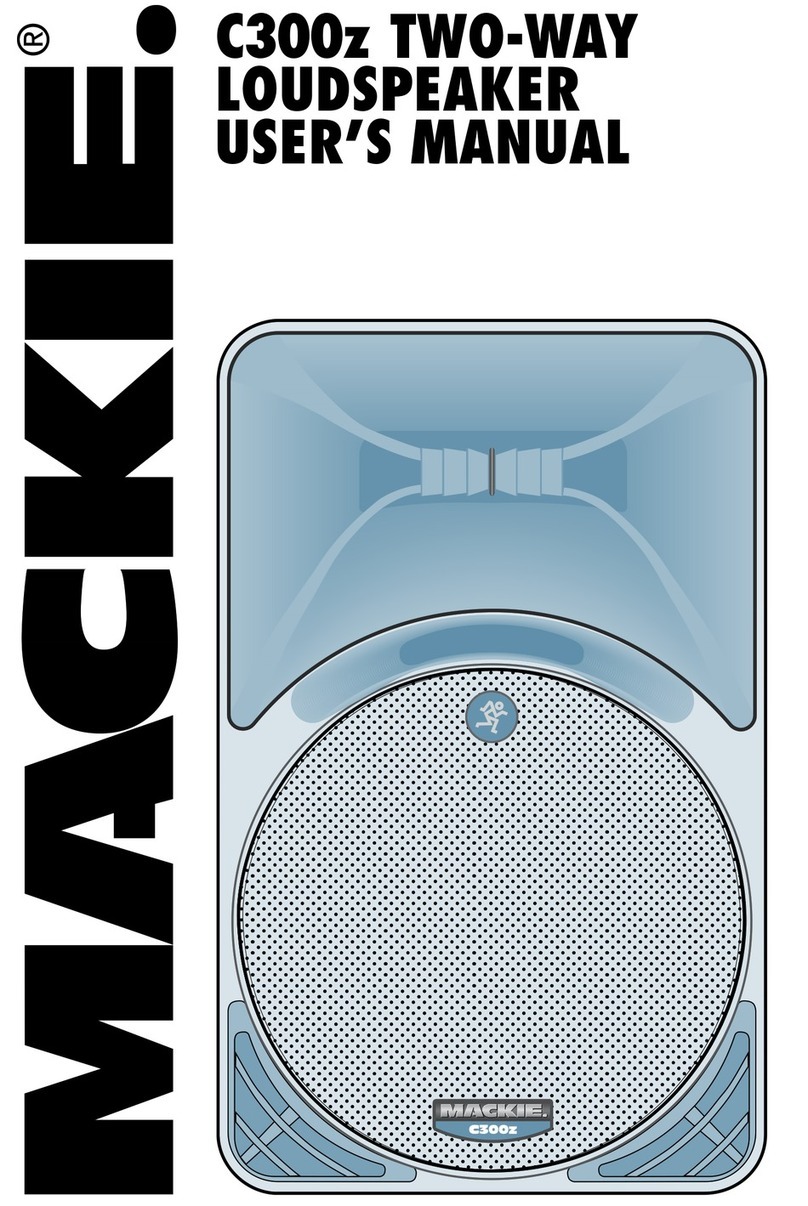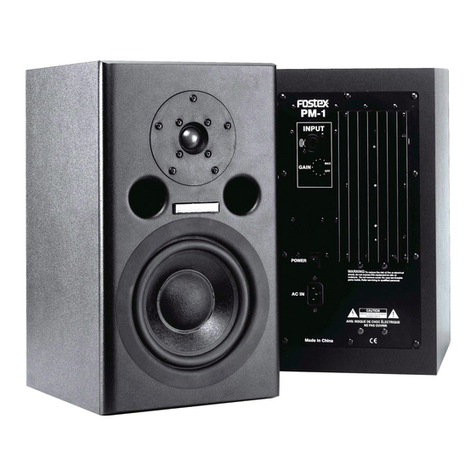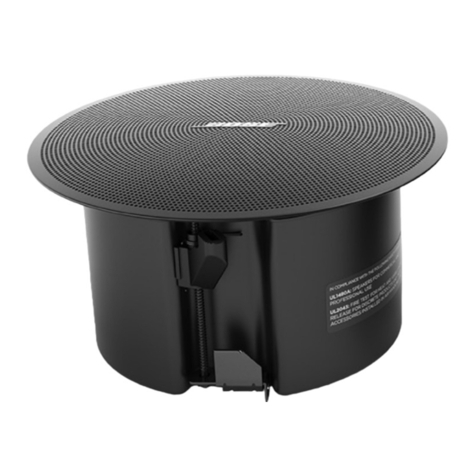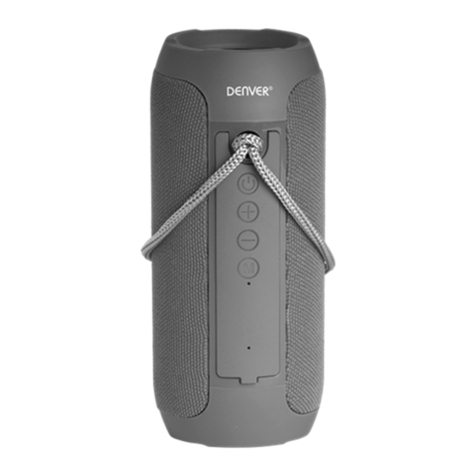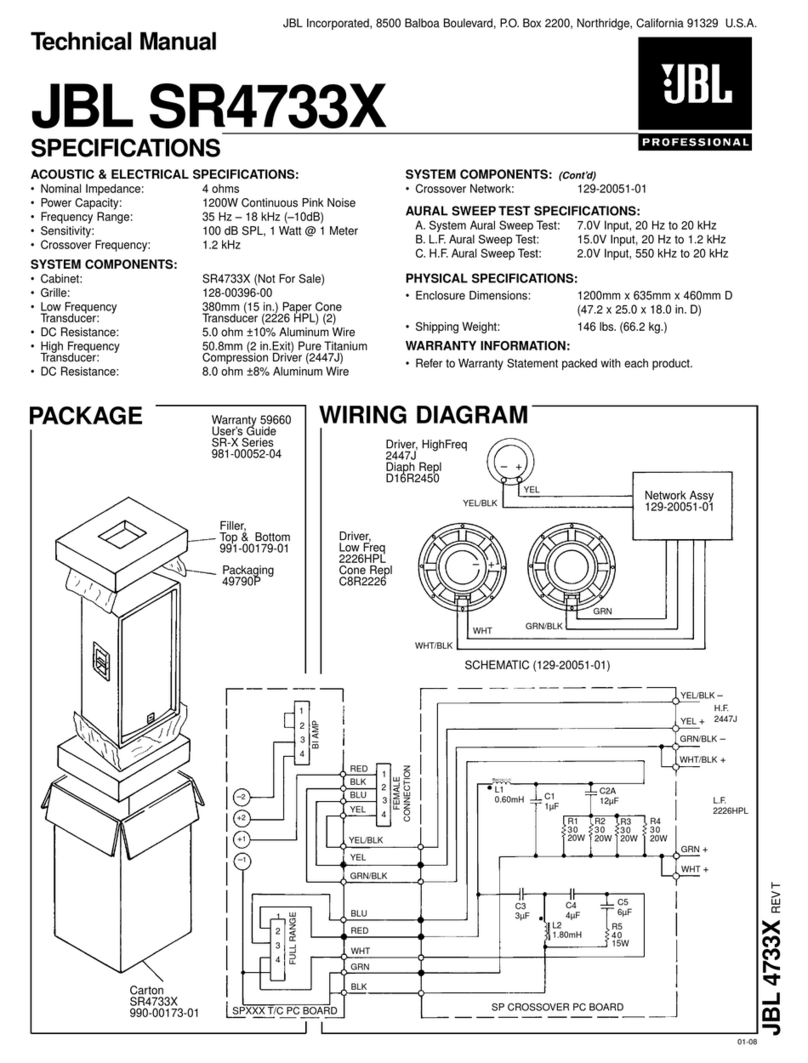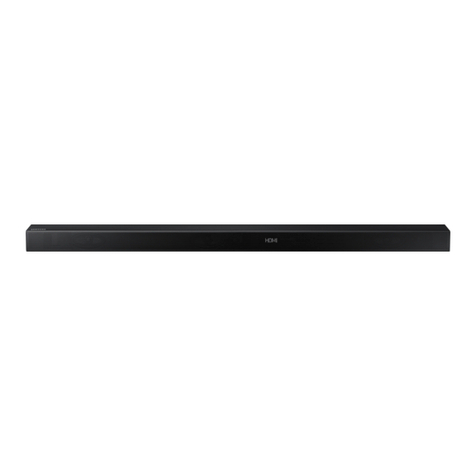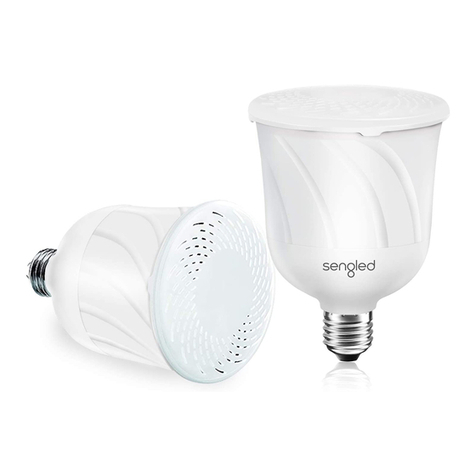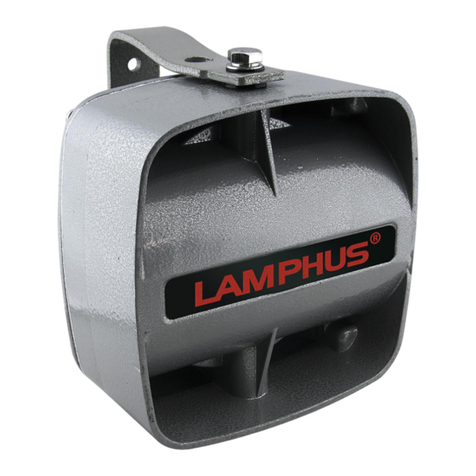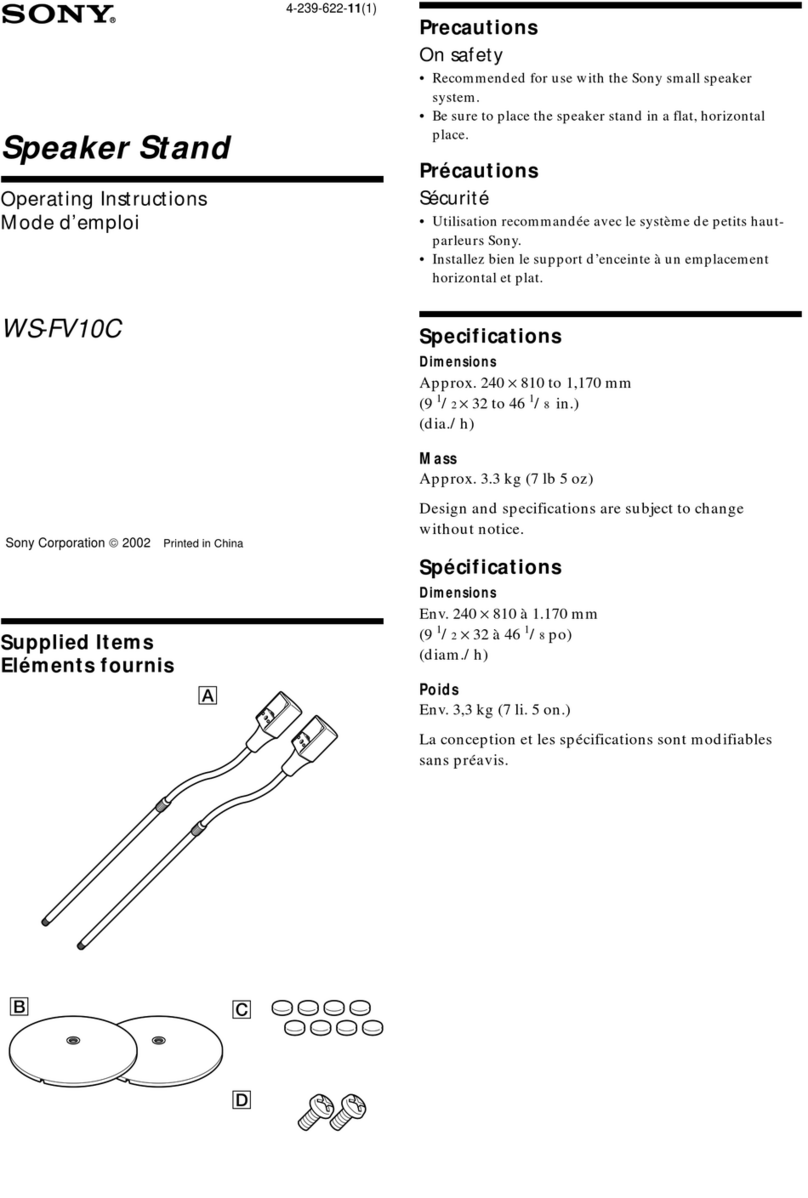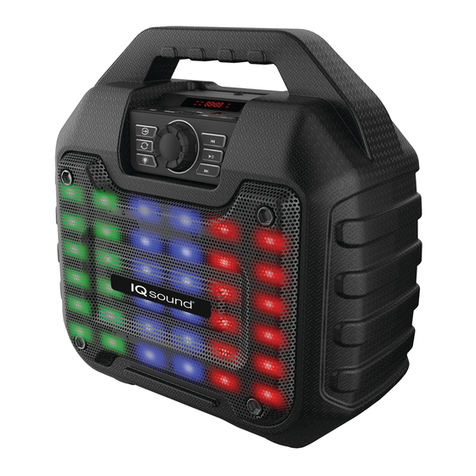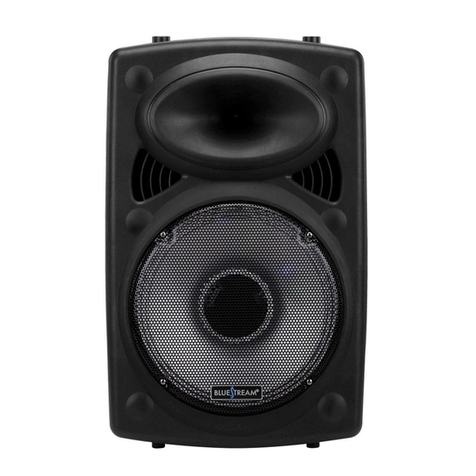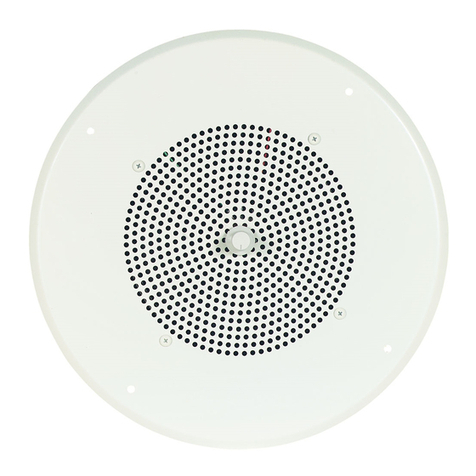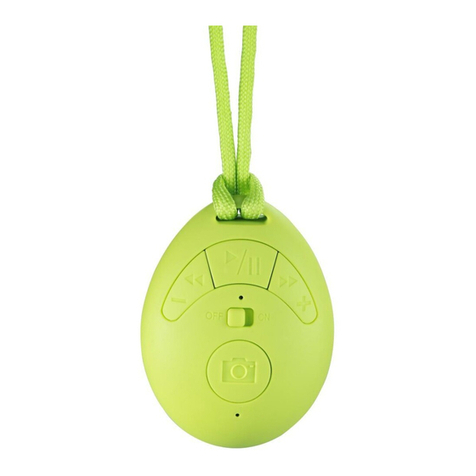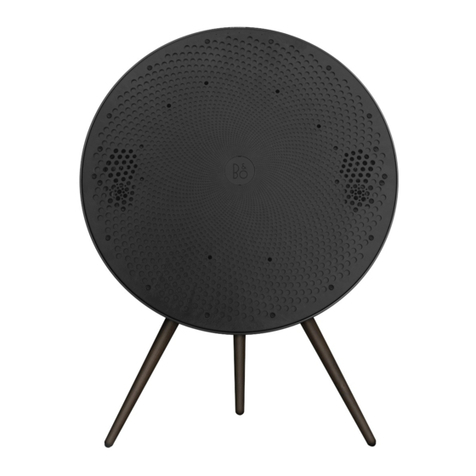Thiel SCS4T Technical manual

OWNER INFORMATION
SCS4T
Coherent Source® Loudspeaker

Congratulations on your purchase of the THIEL SCS4T. This product is the result of a dedicated ef-
fort to provide very accurate and realistic sound reproduction. We have used very high quality com-
ponents and taken great care in the SCS4T’s construction. Properly set up and used with good associated
equipment, the SCS4T will provide you with a great deal of sonic enjoyment for many years.
Kathy Gornik, President/CEO, THIEL Loudspeakers
SPEAKER PLACEMENT
The SCS4T is specically designed to give a high level of performance from a variety of room locations and positions.
Though they are ideally placed well away from walls for the best tonal and spatial performance, they work well within the
constraints of typical domestic use such as near-wall placement. Because the SCS4T is magnetically shielded, it can be
placed on or near video displays without causing picture distortion.
All aspects of speaker placement are dependent on the particular room. Since every room is different, no hard rules can be
given, and experimentation is necessary to achieve the best results. Experiment with both placement of the speakers within
the room and the degree of toe-in to optimize the sound for your environment. It is helpful to not install the spikes until the
speakers are nally positioned.
CONNECTING THE SPEAKERS
The SCS4T’s input terminals are located on the rear of the speaker. The SCS4T uses a 5-way binding post which accepts sev-
eral types of speaker cable termination. Make sure that all connections are tight. The input terminals are designed to be easily
tightened by hand or a 1⁄2inch nut driver can be used.
It is essential for proper performance that both speakers in a stereo system be wired in
the same polarity. The speaker’s input terminals are color coded to facilitate this. The wire
connected to the red ringed input terminal of each speaker should connect to the respec-
tive positive (+) output terminals of the amplier; the wire connected to the black ringed
input terminals should be connected to the respective negative (–) output terminals of the
amplier.
The speakers should be connected to the amplier with high quality cable to ensure
minimal loss of power and proper control by the amplier. If the speakers are being con-
nected to a vacuum tube amplier with various impedance taps, the 4 ohm tap will usually
give the best results.
Rear input panel

BREAK-IN
The SCS4Ts, like most speakers, require a period of playing before they perform optimally. The time depends on how
loudly the speakers are played; more time is required if played softly, less if played loudly. At least 50 hours at moder-
ately loud levels are required before the speaker is performing near optimum. You should notice even more improvement
after 100 hours of playing.
ASSOCIATED EQUIPMENT
The SCS4T is a very high quality sound reproducer and will benet from use with the best associated equipment. Since
it is extremely accurate, it will reveal sources of distortion generated elsewhere in the system. For example, distortion
resulting from poor recordings or inferior electronics will be reproduced accurately. Also, the quality of the interconnect
cables and speaker cables will signicantly effect the performance of the system.
POWER REQUIREMENTS
It is important to have enough power to play at the level you desire without distortion. If you play the speakers more
loudly than the volume the amplier can cleanly produce, the amplier will produce overload (clipping) distortion. The
sound will become compressed, strained, and in extreme cases, obviously distorted. This distortion is actually non-mu-
sical additional energy and since it is concentrated in the high frequency region where the speaker is least able to handle
it, tweeters can be damaged in extreme cases. If high sound levels are desired, the SCS4Ts are designed to be used with
ampliers rated up to 200 watts per channel.
Keep in mind that sound quality is usually more important than sound quantity. There can be large differences in the
sonic performance of two ampliers of equal power, and this is more important than large differences in power. Most
everyone will be happier with a 100 watt amplier of high sonic quality than a 200 watt amplier of mediocre sonic
quality. For this reason, we feel there is no substitute for listening in making your amplier decision.
The question “how much power do I need?” does not have the simple answer most people expect because it is not
determined only by the loudspeaker’s efciency, but also by the volume desired and the size of the room. If all three
factors are average, about 100 watts per channel is required. Each factor can raise or lower this amount by about three
times.
1) Usually, people who “don’t like music loud” can decrease their power to about one-half. Also, people who like mu-
sic loud should increase their power by 2 times or more. Most people fall within a normal range.
2) A speaker with a low efciency of 84dB/2.8 V-1-m will require twice the power of an average 87dB/2.8 V-1-m
speaker and one with a high rating of 90dB/2.8 V-1-m will require only half the power of an average speaker. The
SCS4T is of average efciency (87dB) and therefore can achieve average output levels with an average amount of
power.
3) A small room will need less power for a given loudness level than a large room. A very small room of 1000 cu. ft.
(11' x 11' with an 8' ceiling) will require about half the power of an average size room. A large room of 6000 cu. ft. (20'
x 30' with a 10' ceiling) will require twice the average power. If the listening room is connected to another room by a
large open area, the required power will increase but not by the amount of the combined room volume. If the room has
a “dropped” ceiling with light panels, the ceiling will be almost transparent acoustically and the space above the ceiling
should be added. If the panels are heavy, they will act as a more normal ceiling.
With all this in mind, a person who doesn’t like to play music very loudly and has a small room can get quality sound
with the SCS4T with 50 watts or even less whereas a person who sometimes likes to play loudly and has a large room
may need 200 watts or more.

The Following Noises Can Be Dangerous
Under Constant Exposure
90 Subway, motorcycle, truck trafc, lawn mower
100 Garbage truck, chain saw, pneumatic drill
120 Rock concert in front of speakers, thunderclap
140 Gunshot blast, jet plane
150 Rocket launching pad
Decibel
Level Example
30 Quiet library, soft whispers
40 Living room, refrigerator, bedroom away from
trafc
50 Light trafc, normal conversation, quiet ofce
60 Air conditioner at 20 feet, sewing machine
70 Vacuum cleaner, hair dryer, noisy restaurant
80 Average city trafc, garbage disposals, alarm
clock at two feet
We Want You Listening For A Lifetime
Used wisely, your new sound equipment will provide a lifetime of enjoyment. Since hearing damage from loud
noise is often undetectable until it is too late, THIEL Loudspeakers and the Electronics Industries Manufacturers
Association recommend you avoid prolonged exposure to excessive noise. Depending on room size and amplier
power, some home audio systems can reach sound pressure levels in excess of 95 decibels with peaks of over a 105
decibels. For your protection, the list below identies sound levels for various noises.
Information courtesy of the Deafness
Research Foundation and the EIA.
CABINET FINISH CARE
THIEL Loudspeakers wood cabinets possess a high quality lacquer nish that is both beautiful and durable. However, any
wood nish can be damaged by excessive moisture, dryness, or direct sunlight. When cleaning your speakers, avoid using
oils, waxes, or polishes that contain silicone, such as Pledge or Johnson’s. We recommend using Endust.
SERVICE
If your speaker system requires service, contact your authorized THIEL Loudspeakers dealer. If you need to contact THIEL
Loudspeakers directly, service information and technical support is available at (859) 254-9427, Monday-Friday, 8:30 a.m. -
5:00 p.m. EST, or via e-mail at [email protected]. THIEL Loudspeakers dealer information and a “Frequently Asked
Questions” section can be found on our web site, www.thielaudio.com.

THIEL SCS4T SPECIFICATIONS
Amplitude Response 47Hz-20kHz,-3dB
Phase Response Minimum±10°
Sensitivity 87[email protected]V-1m
Impedance 4ohms(3ohmsminimum)
Recommended Power 30-200watts
Size 8.4"Wx10.8"Dx17.6"L
Weight 25pounds
THIEL SCS4T CABINET DIMENSIONS
965mm / 38"
1073mm / 42.25"
322mm / 12.67"
213mm / 8.38" 320mm / 12.60"

1010
THIEL Loudspeakers
1026NandinoBoulevard
Lexington,Kentucky40511-1207
Ph:859-254-9427•[email protected]
You can also register your warranty online at www.thielaudio.com.
LIMITED WARRANTY
THIEL Loudspeakers warrants every THIEL model SCS4T system against defects in materials and workmanship to the
original owner for a period of ten years from the date of purchase. THIEL will, at no charge, replace any defective part and
make any repairs necessary to ensure its proper performance when the defective unit is returned to us postpaid.
This warranty does not cover damage due to accident or abuse and is void if the unit has been tampered with.
This warranty is automatic and no registration is required. This warranty gives you specic legal rights. You may also
have other rights which are particular to your state.
The following information is for your records.
Serial Numbers______________________________
Purchase Date_______________________________
Purchased From_____________________________
www.thielaudio.com
Table of contents
Other Thiel Speakers manuals
